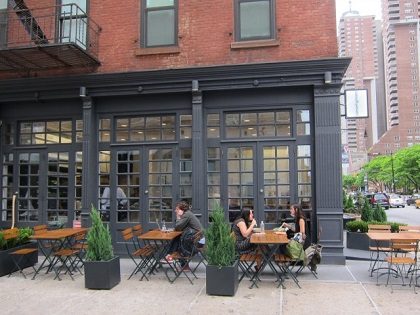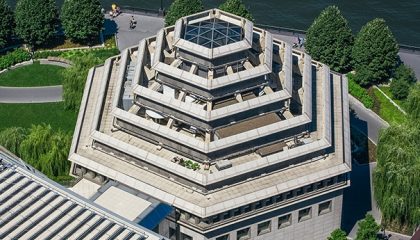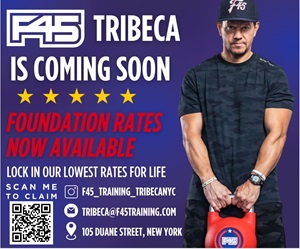Categories
Left column house ads
In the News: Sweetgreen will take your cash
April 29, 2019 Real Estate, Restaurant/Bar News

SWEETGREEN GOING GREEN
From Gothamist: Sweetgreen announced yesterday that it would start accepting cash in all of its locations by the end of 2019. “Ultimately, we have realized that while being cashless has advantages, today it is not the right solution to fulfill our mission,” Sweetgreen said in a statement on Medium. “To accomplish our mission, everyone in the community needs to have access to real food.”
JEWISH MUSEUM ARCHITECT DIES
Archpaper, the architect’s newspaper, has an interesting obit for Kevin Roche, who among many other city landmarks, designed the Museum of Jewish Heritage. Here’s their lede: The death of architect Kevin Roche on March 1 at 96 marked the end of an era—the midcentury modern era that the work of his mentor, Eero Saarinen, came to symbolize. Roche and his late partner, John Dinkeloo, founded the successor firm that finished a number of the projects that remained incomplete when Saarinen died in 1961 at 51.
ADJAYE PROJECT AT 130 WILLIAM UP CLOSE
New York YIMBY has some close-up photos of the construction of 130 William, the first NYC project by Sir David Adjaye of Adjaye Associates. Lightstone Group is the developer. The building is 66 floors and 800 feet tall.
CONGESTION PRICING = ‘PEDESTRIAN PARADISE’
The Wall Street Journal interviews transportation commish Polly Trottenberg, who says congestion pricing “could also lead to wider sidewalks, expanded bus and bike lanes, and new pedestrian plazas. ‘It certainly would open up a lot of pretty transformative possibilities.’”
12 Comments
Comment:
Subscribe
Subscribe to the TC Newsletter



















YES to wider sidewalks!
They were once far wider….Narrowing them was a mistaken vision of progress, prioritizing cars over pedestrians.
The New York of 2016 Needs the Wide, Generous Sidewalks of 1906
https://nyc.streetsblog.org/2016/07/01/the-new-york-of-2016-needs-the-wide-generous-sidewalks-of-1906/
Space for Chobani yogurt bar inside Target Tribeca location is under going renovation. Also a wine store is coming to the former Game Stop space on Greenwich.
Anyone know if Chobani is really closing vs renovating?
Closed. Target is expanding into it.
I wish the Five and Dime in the Woolworth building would take cash and not just credit or debit cards.
Especially since it’s a Five and Dime!
I have a question regarding congestion pricing: what effect will it have on tunnel traffic in Tribeca since it is unclear whether or not incoming tunnel traffic will be required to pay an additional fee after having paid the tunnel fee. Will it mollify Canal Street and Church/6th avenue traffic?
I’ve been trying to cross 6th and White for over 40 years without cars busses and trucks blocking the crosswalks and intersection.
Yes, I have this question, too.
I believe we still have to petition the powers that be to enforce traffic laws against matters like:
– blocking the intersection “box”
– blocking pedestrian walkways
– running red lights
– speeding
– non-emergency honking
and so on.
All of this seems to have become much worse in just the past few years. I don’t know if any such issues are covered in the congesting pricing legislation; probably not since these are separate free-standing laws.
Canal Street in particular feels like a depressing lawless zone, between the Mad Mad style of driving and all the fake “vendors” blocking the sidewalks.
Congestion pricing will greatly diminish downtown traffic by reducing the number of car and truck trips into lower Manhattan via the three now-free bridges from Brooklyn.
More on that here: https://nyc.streetsblog.org/2018/12/28/op-ed-varick-street-crossing-guards-are-telling-a-tale-of-congestion-pricing/. If you want to go even deeper, download the Sam Schwartz study linked to in that post.
Congestion pricing is being implemented without crossing every “T” and dotting every “I”. No one knows what the tolls will be or how often they will have to be raised. How much is it going to cost to construct a system to record the tolls? The proponents are full of unproved theories. One thing I’ve observed from 34 years of business experience in Tribeca, is that less traffic means less business. If you like empty storefronts, you’ll love congestion pricing.
I think the opposite will be true. I hope that congestion pricing dissuades the drivers passing through who use Broome and Canal Streets as a modern-day LOMEX just to avoid tolls. Those drivers do not shop in the area and that traffic only puts off those actual potential shoppers who think (like Yogi Berra said), “Nobody goes there anymore. It’s too crowded.”
There’s still more than a year to figure out those details.
The article says charges will be done either electronically or based on photos of license plates.
I would assume (or hope) that this implementation will be derived from studies of experience of other cities, especially London, Stockholm, and so on.